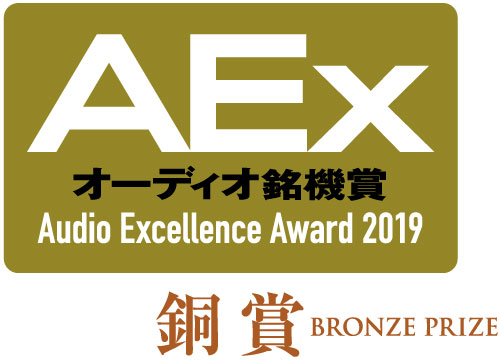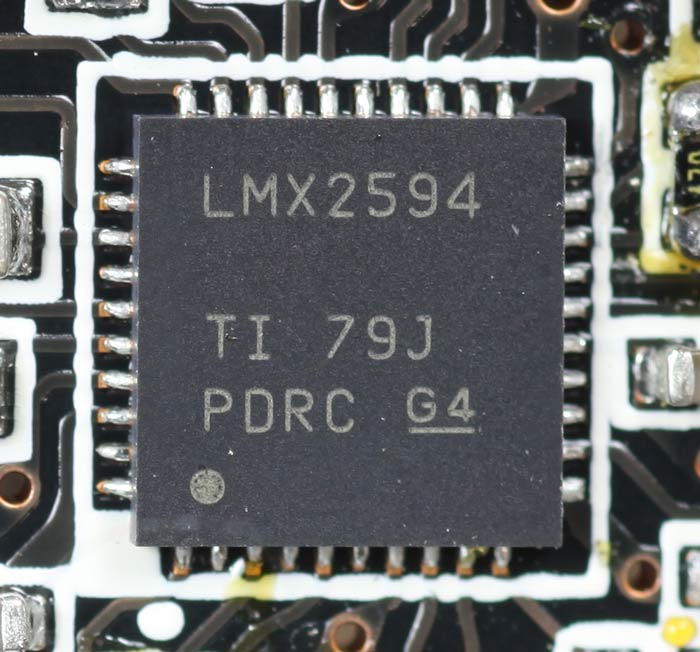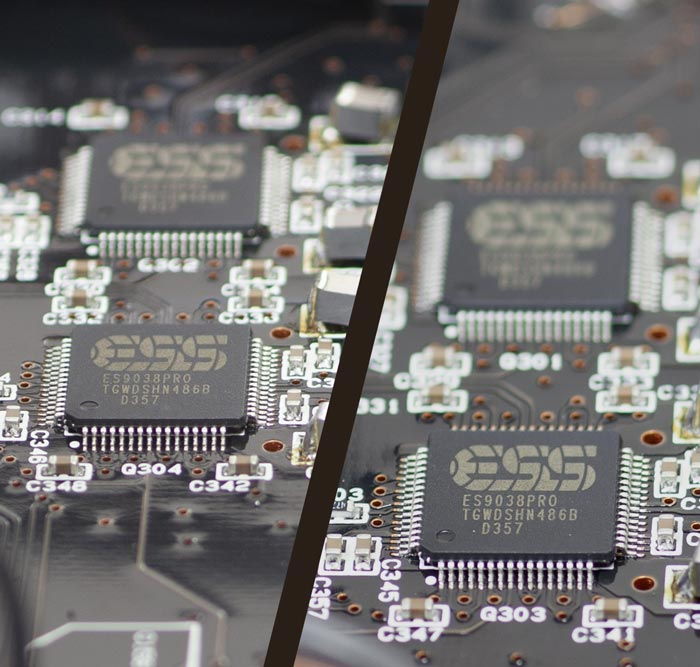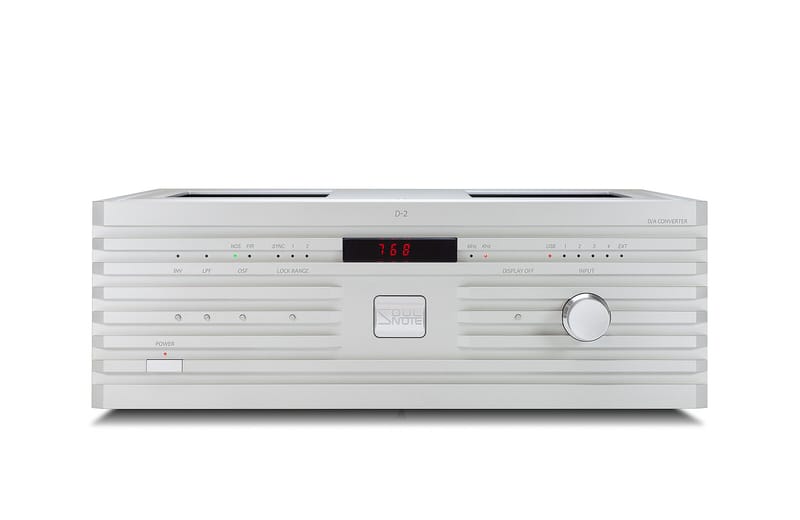A DDS using the LMX2594 super low jitter features with external clock generator inputs. A perfectly symmetric, discrete non-NFB D/A converter that uses a total of four ES9038PRO circuits and supports non-over sampling.
- Category: Series 2
Description






 D/A Converter
D/A Converter
PREMIUM SILVER / PREMIUM BLACK
A DDS using the LMX2594 super low jitter features with external clock generator inputs.
A perfectly symmetric, discrete non-NFB D/A converter that uses a total of four ES9038PRO circuits and supports non-oversampling.
 The DSS uses the LMX2594 from Texas Instruments
The DSS uses the LMX2594 from Texas Instruments D/A converter formats that recreate the required master clock from reference clocks typically use a DDS (Direct Digital Synthesizer). The performance of external clock generators in this format guarantees frequency accuracy (e.g. how many seconds of deviance will occur over tens of thousands of years), but jitter (fluctuations in waveform width arising in the clock) and the resulting phase noise are highly dependent on the performance of the DDS itself. By convention, audio equipment generally uses DDS-specific ICs with 10 ps (picosecond) jitter functions, but the D-2 is the first device to use Texas Instrument's PLLatinum™ RF LMX2594 synthesizer for an audio DDS. The LMX2594 synthesizer was developed for radars and measurement instruments and boasts the world's highest specifications with performance index of -236 dBc/Hz and jitter of 45 fs (femtosecond, 1/1000 of a picosecond). This ultralow jitter DDS results in an overwhelmingly clear and deep spatial presentation when inputting the high-precision external clock and using the built-in TCXO.
D/A converter formats that recreate the required master clock from reference clocks typically use a DDS (Direct Digital Synthesizer). The performance of external clock generators in this format guarantees frequency accuracy (e.g. how many seconds of deviance will occur over tens of thousands of years), but jitter (fluctuations in waveform width arising in the clock) and the resulting phase noise are highly dependent on the performance of the DDS itself. By convention, audio equipment generally uses DDS-specific ICs with 10 ps (picosecond) jitter functions, but the D-2 is the first device to use Texas Instrument's PLLatinum™ RF LMX2594 synthesizer for an audio DDS. The LMX2594 synthesizer was developed for radars and measurement instruments and boasts the world's highest specifications with performance index of -236 dBc/Hz and jitter of 45 fs (femtosecond, 1/1000 of a picosecond). This ultralow jitter DDS results in an overwhelmingly clear and deep spatial presentation when inputting the high-precision external clock and using the built-in TCXO.Supports 10 MHZ external reference clock inputs
 Using a DDS with jitter functionality that surpasses quartz means that the D-2 comes with 10 MHz external reference clock inputs, a SOULNOTE first. The internal clock relies on a high performance TCXO boasting stunning phase noise (-121 dB at 10 Hz offset). It also features a high frequency relay with mechanical contacts to avoid additional jitter from the IC when switching between the internal clock and an external clock generator. The internal clock power supply shuts off and vibrations stop when using an external clock generator, this way removing any risk of mutual interference.
Using a DDS with jitter functionality that surpasses quartz means that the D-2 comes with 10 MHz external reference clock inputs, a SOULNOTE first. The internal clock relies on a high performance TCXO boasting stunning phase noise (-121 dB at 10 Hz offset). It also features a high frequency relay with mechanical contacts to avoid additional jitter from the IC when switching between the internal clock and an external clock generator. The internal clock power supply shuts off and vibrations stop when using an external clock generator, this way removing any risk of mutual interference.Uses 4 ES9038PRO (industry's first)

 Two ES9038PROs per channel are employed for the upper and lower differential complementary inputs in this SOULNOTE original fully symmetric non-NFB discrete amplifier, completely driving the initial stage in the non-NFB differential amplifier. The IV circuits are extremely simple with only one resistor to eliminate TIM distortion which can be so problematic with feedback type IV. With an extremely powerful 120 mA, two ES9038PROs are used in each channel to allow natural music playback bursting with life. The ES9038PRO operates in synchronous mode to obtain the highest sound quality.
Two ES9038PROs per channel are employed for the upper and lower differential complementary inputs in this SOULNOTE original fully symmetric non-NFB discrete amplifier, completely driving the initial stage in the non-NFB differential amplifier. The IV circuits are extremely simple with only one resistor to eliminate TIM distortion which can be so problematic with feedback type IV. With an extremely powerful 120 mA, two ES9038PROs are used in each channel to allow natural music playback bursting with life. The ES9038PRO operates in synchronous mode to obtain the highest sound quality.NOS mode
In addition to the conventional FIR oversampling mode, the D-2 also has the new NOS(non-oversampling)mode, which is a non-NFB version adapted to operate in the digital domain. This mode does not generate the pre- and post-echoes observed in FIR oversampling. It also suppresses extremely low noise levels with analog outputs, with no difference in levels between the two modes.
 Impulse output waveform with an FIR oversampling filter (D-2 analog output)Pre- and post-echoes are artificial "sounds" created by data calculations before and after the data is interpolated. They make waveforms like sine waves appear smoother, but calculation algorithms can affect the sound quality or ambiguity and be added to the time axis.
Impulse output waveform with an FIR oversampling filter (D-2 analog output)Pre- and post-echoes are artificial "sounds" created by data calculations before and after the data is interpolated. They make waveforms like sine waves appear smoother, but calculation algorithms can affect the sound quality or ambiguity and be added to the time axis. Impulse output waveform in NOS mode (D-2 analog output)This waveform can only be achieved by combining a non-NFB discrete amplifier with superb transient response performance. Because music waveforms are actually a series of impulse waveforms of different heights, the NOS mode eliminates any ambiguity in the time axis information, creating more realistic and natural sound quality and an expansive listening environment to the hearing acuity of humans, which is extremely sensitive to the time axis.* The NOS mode cannot be used with DSD.
Impulse output waveform in NOS mode (D-2 analog output)This waveform can only be achieved by combining a non-NFB discrete amplifier with superb transient response performance. Because music waveforms are actually a series of impulse waveforms of different heights, the NOS mode eliminates any ambiguity in the time axis information, creating more realistic and natural sound quality and an expansive listening environment to the hearing acuity of humans, which is extremely sensitive to the time axis.* The NOS mode cannot be used with DSD.Dual mono construction using fully discrete non-NFB differential amplifiers
The SOULNOTE original discrete fully symmetric non-NFB differential amplifiers are arranged in a dual mono construction that is completely placed independently on the left and right channels, including the power supply rectifier. In addition, connecting cables have been eliminated for sound signals and in power supplies. Wiring from the transformer, a high current loop, has also been minimized.
400 VA bifilar wound high-regulation toroidal transformers with eight windings on the secondary side
The D-2 incorporates the newly developed power transformers with eight windings on the secondary side that are capable of regulation similar to that of very high power amplifiers. Independent rectifier circuits in each stage prevent interference. Because transformers are a source of vibration, SOULNOTE has used only one in each unit to simplify the vibration type and has constructed the unit body so that any unwanted vibration is transmitted away from the body through a spike placed directly under each transformer.
Noise countermeasures that don't rely on filters
The D-2 uses 4 boards wrapped in 70-micron thick copper foil that eliminates noise by optimizing the printed circuit board layout. Noise countermeasures that don't rely on filters that can impact sound quality like ferrite, etc. are employed throughout, and each mode keeps unwanted radiation below the noise floor.
An independent digital board layout with consideration of future upgrades
The digital boards are independent structures with one portion connected to the rear panel, allowing for upgrades in the future.The connection to the analog circuit use soldered pin heads, eliminating sound quality deterioration caused by contact resistance in connectors.
Expandable to dual mono DAC
STEREO, MONO Lch, and MONO Rch modes can be selected on the D-2. In MONO mode, by stopping the ES9038PROs on the opposite channel, thus doubling the power margin and making channel separation practically infinite.
Uses the groundbreaking Bulk Pet transfer method
 USB-Audio generally transfers data using the Isochronous transfer method. The D-2 uses Bulk Pet, a new Bulk transfer method developed by Interface Corporation. This method results in reduced loads for computers and D/A converters, leading to the a further dimension in playback sound quality.* Dedicated drivers must be installed on your computer when using Bulk Pet. Download them here
USB-Audio generally transfers data using the Isochronous transfer method. The D-2 uses Bulk Pet, a new Bulk transfer method developed by Interface Corporation. This method results in reduced loads for computers and D/A converters, leading to the a further dimension in playback sound quality.* Dedicated drivers must be installed on your computer when using Bulk Pet. Download them hereSpecifications
Model name D-2SE(PREMIUM SILVER)/D-2BE(PREMIUM BLACK)
Input format(USB) PCM, DSD (DoP v1.1, ASIO native)
Input format(Coaxial・AES/EBU) PCM,DSD(DoP v1.1)
Supported sampling frequency(USB) Max.768kHz (PCM) / Max.22.6MHz (DSD)
Supported sampling frequency(Coaxial・AES/EBU) Max.192kHz (PCM) / Max.2.8MHz (DSD64 DoP v1.1)
PCM quantization bit rate(USB) 16bit, 24bit, 32bit
PCM quantization bit rate(Coaxial・AES/EBU) 16bit, 24bit
Digital input USB (Type B)、coaxial x2(SPDIF)、AES/EBU x2
External clock input 10MHz (BNC50 ohm)
Analog output XLR x1、RCA x1
Analog output level(XLR) 5.6Vrms
Analog output level(RCA) 2.8Vrms
Frequency characteristic 2Hz to 120kHz (+0/-1dB)
SN ratio 110dB
Total harmonic distortion 0.008%(NOS/176.4kHz)
Analog filter Two-dimensional passive
Power voltage 230V AC 50Hz
Power consumption 56W
Maximum external dimensions Main unit: 430(W)×160(H)×405(D)mm
Weight 17kg
Included accessories Spikes,Power cord
Rear panel

Included accessories
Spikes,Power cord

